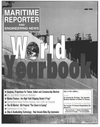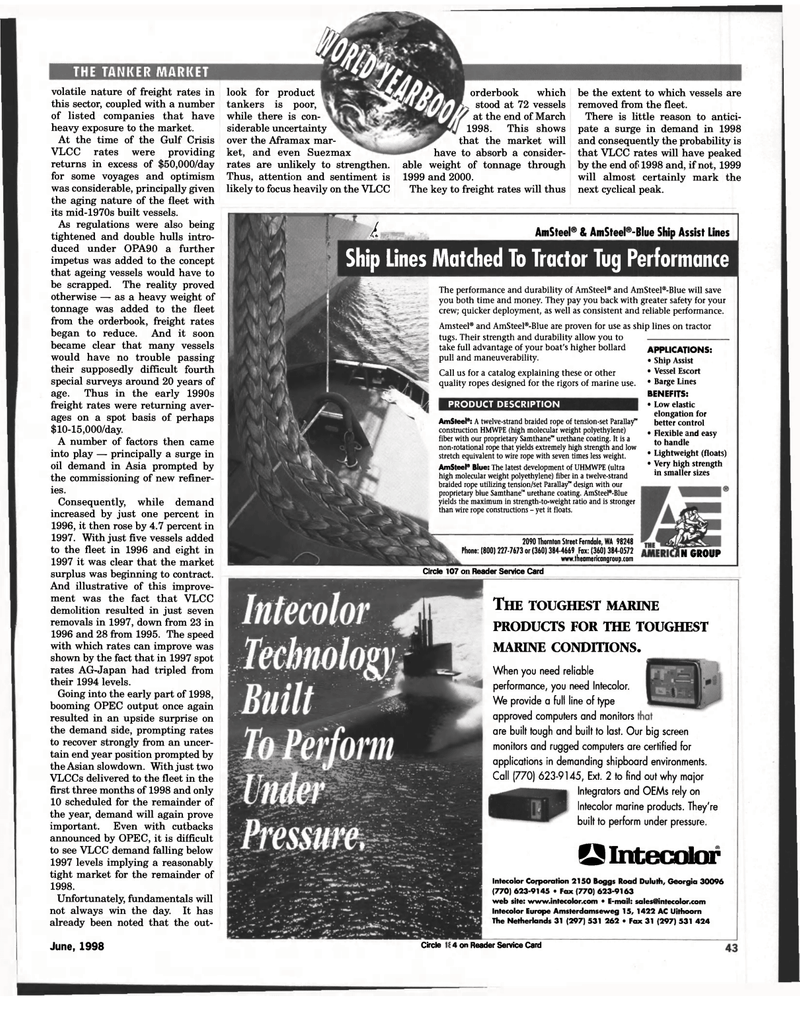
Page 43: of Maritime Reporter Magazine (June 1998)
Read this page in Pdf, Flash or Html5 edition of June 1998 Maritime Reporter Magazine
volatile nature of freight rates in this sector, coupled with a number of listed companies that have heavy exposure to the market.
At the time of the Gulf Crisis
VLCC rates were providing returns in excess of $50,000/day for some voyages and optimism was considerable, principally given the aging nature of the fleet with its mid-1970s built vessels.
As regulations were also being tightened and double hulls intro- duced under OPA90 a further impetus was added to the concept that ageing vessels would have to be scrapped. The reality proved otherwise — as a heavy weight of tonnage was added to the fleet from the orderbook, freight rates began to reduce. And it soon became clear that many vessels would have no trouble passing their supposedly difficult fourth special surveys around 20 years of age. Thus in the early 1990s freight rates were returning aver- ages on a spot basis of perhaps $10-15,000/day.
A number of factors then came into play — principally a surge in oil demand in Asia prompted by the commissioning of new refiner- ies.
Consequently, while demand increased by just one percent in 1996. it then rose by 4.7 percent in 1997. With just five vessels added to the fleet in 1996 and eight in 1997 it was clear that the market surplus was beginning to contract.
And illustrative of this improve- ment was the fact that VLCC demolition resulted in just seven removals in 1997, down from 23 in 1996 and 28 from 1995. The speed with which rates can improve was shown by the fact that in 1997 spot rates AG-Japan had tripled from their 1994 levels.
Going into the early part of 1998, booming OPEC output once again resulted in an upside surprise on the demand side, prompting rates to recover strongly from an uncer- tain end year position prompted by the Asian slowdown. With just two
VLCCs delivered to the fleet in the first three months of 1998 and only 10 scheduled for the remainder of the year, demand will again prove important. Even with cutbacks announced by OPEC, it is difficult to see VLCC demand falling below 1997 levels implying a reasonably tight market for the remainder of 1998.
Unfortunately, fundamentals will not always win the day. It has already been noted that the out-
June, 1998 look for product tankers is poor, while there is con- siderable uncertainty over the Aframax mar- ket, and even Suezmax rates are unlikely to strengthen.
Thus, attention and sentiment is likely to focus heavily on the VLCC orderbook which stood at 72 vessels at the end of March 1998. This shows that the market will have to absorb a consider- able weight of tonnage through 1999 and 2000.
The key to freight rates will thus be the extent to which vessels are removed from the fleet.
There is little reason to antici- pate a surge in demand in 1998 and consequently the probability is that VLCC rates will have peaked by the end of 1998 and, if not, 1999 will almost certainly mark the next cyclical peak.
I AmSteel® & AmSteel®-Blue Ship Assist Lines
Ship Lines Matched To Tractor Tug Performance
The performance and durability of AmSteel® and AmSteel®-Blue will save you both time and money. They pay you back with greater safety for your crew; quicker deployment, as well as consistent and reliable performance.
Amsteel® and AmSteel®-Blue are proven for use as ship lines on tractor tugs. Their strength and durability allow you to take full advantage of your boat's higher bollard pull and maneuverability.
Call us for a catalog explaining these or other quality ropes designed for the rigors of marine use.
PRODUCT DESCRIPTION
AmSteel®: A twelve-strand braided rope of tension-set Parallay™ construction HMWPE (high molecular weight polyethylene) fiber with our proprietary Samthane™ urethane coating. It is a non-rotational rope that yields extremely high strength and low stretch equivalent to wire rope with seven times less weight.
AmSteel® Blue: The latest development of UHMWPE (ultra high molecular weight polyethylene) fiber in a twelve-strand braided rope utilizing tension/set Parallay™ design with our proprietary blue Samthane™ urethane coating. AmSteel®-Blue yields the maximum in strength-to-weight ratio and is stronger than wire rope constructions - yet it floats. 2090 Thornton Street ferndale, WA 98248
Phone: (800) 227-7673 or (360) 384-4669 Fax: (360) 384-0572 www.theamericangroup.com
APPLICATIONS: • Ship Assist • Vessel Escort • Barge Lines
BENEFITS: • Low elastic elongation for better control • Flexible and easy to handle • Lightweight (floats) • Very high strength in smaller sizes
N GROUP
Circle 240 on Reader Service Card 45
Intecolor Corporation 2150 Boggs Road Duluth, Georgia 30096 (770) 623-9145 • Fax (770) 623-9163 web site: www.intecolor.com • E-mail: [email protected]
Intecolor Europe Amsterdamseweg 15, 1422 AC Uithoorn
The Netherlands 31 (297) 531 262 • Fax 31 (297) 531 424
Circle 107 on Reader Service Card
SS Intecolor
THE TOUGHEST MARINE
PRODUCTS FOR THE TOUGHEST
MARINE CONDITIONS.
When you need reliable performance, you need Intecolor.
We provide a full line of type approved computers and monitors are built tough and built to last. Our big screen monitors and rugged computers are certified for applications in demanding shipboard environments.
Call (770) 623-9145, Ext. 2 to find out why major
Integrators and OEMs rely on
Intecolor marine products. They're built to perform under pressure.

 42
42

 44
44
